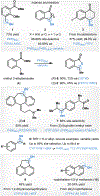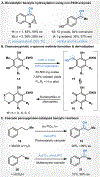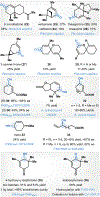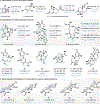Scalable biocatalytic C-H oxyfunctionalization reactions
- PMID: 32701110
- PMCID: PMC8177087
- DOI: 10.1039/d0cs00440e
Scalable biocatalytic C-H oxyfunctionalization reactions
Abstract
Catalytic C-H oxyfunctionalization reactions have garnered significant attention in recent years with their ability to streamline synthetic routes toward complex molecules. Consequently, there have been significant strides in the design and development of catalysts that enable diversification through C-H functionalization reactions. Enzymatic C-H oxygenation reactions are often complementary to small molecule based synthetic approaches, providing a powerful tool when deployable on preparative-scale. This review highlights key advances in scalable biocatalytic C-H oxyfunctionalization reactions developed within the past decade.
Conflict of interest statement
Conflicts of interest
There are no conflicts to declare.
Figures










References
Publication types
MeSH terms
Substances
Grants and funding
LinkOut - more resources
Full Text Sources
Miscellaneous

